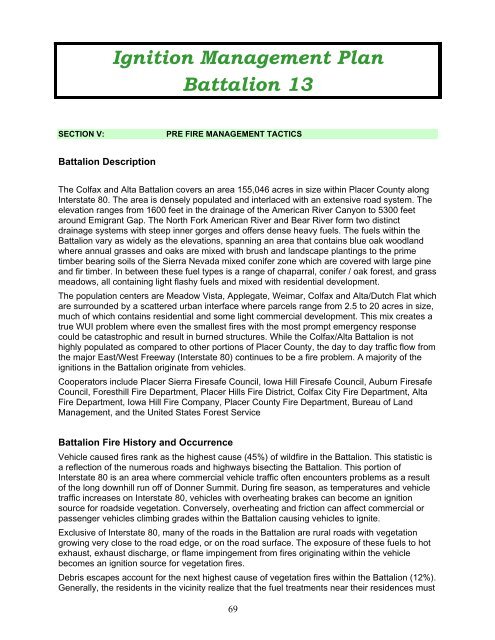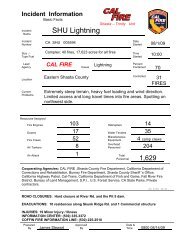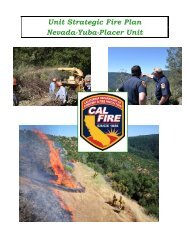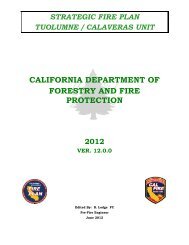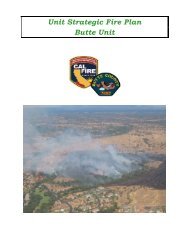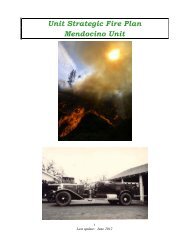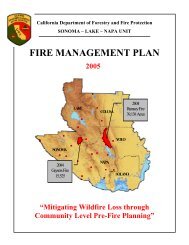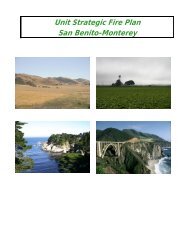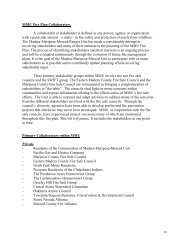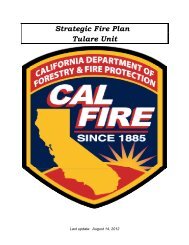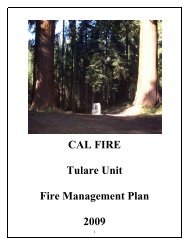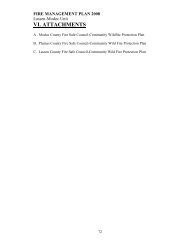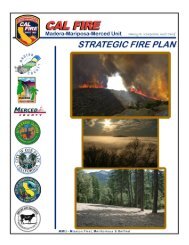Nevada-Yuba-Placer Strategic Fire Plan 2011 - Board of Forestry ...
Nevada-Yuba-Placer Strategic Fire Plan 2011 - Board of Forestry ...
Nevada-Yuba-Placer Strategic Fire Plan 2011 - Board of Forestry ...
Create successful ePaper yourself
Turn your PDF publications into a flip-book with our unique Google optimized e-Paper software.
Ignition Management <strong>Plan</strong><br />
Battalion 13<br />
SECTION V: PRE FIRE MANAGEMENT TACTICS<br />
Battalion Description<br />
The Colfax and Alta Battalion covers an area 155,046 acres in size within <strong>Placer</strong> County along<br />
Interstate 80. The area is densely populated and interlaced with an extensive road system. The<br />
elevation ranges from 1600 feet in the drainage <strong>of</strong> the American River Canyon to 5300 feet<br />
around Emigrant Gap. The North Fork American River and Bear River form two distinct<br />
drainage systems with steep inner gorges and <strong>of</strong>fers dense heavy fuels. The fuels within the<br />
Battalion vary as widely as the elevations, spanning an area that contains blue oak woodland<br />
where annual grasses and oaks are mixed with brush and landscape plantings to the prime<br />
timber bearing soils <strong>of</strong> the Sierra <strong>Nevada</strong> mixed conifer zone which are covered with large pine<br />
and fir timber. In between these fuel types is a range <strong>of</strong> chaparral, conifer / oak forest, and grass<br />
meadows, all containing light flashy fuels and mixed with residential development.<br />
The population centers are Meadow Vista, Applegate, Weimar, Colfax and Alta/Dutch Flat which<br />
are surrounded by a scattered urban interface where parcels range from 2.5 to 20 acres in size,<br />
much <strong>of</strong> which contains residential and some light commercial development. This mix creates a<br />
true WUI problem where even the smallest fires with the most prompt emergency response<br />
could be catastrophic and result in burned structures. While the Colfax/Alta Battalion is not<br />
highly populated as compared to other portions <strong>of</strong> <strong>Placer</strong> County, the day to day traffic flow from<br />
the major East/West Freeway (Interstate 80) continues to be a fire problem. A majority <strong>of</strong> the<br />
ignitions in the Battalion originate from vehicles.<br />
Cooperators include <strong>Placer</strong> Sierra <strong>Fire</strong>safe Council, Iowa Hill <strong>Fire</strong>safe Council, Auburn <strong>Fire</strong>safe<br />
Council, Foresthill <strong>Fire</strong> Department, <strong>Placer</strong> Hills <strong>Fire</strong> District, Colfax City <strong>Fire</strong> Department, Alta<br />
<strong>Fire</strong> Department, Iowa Hill <strong>Fire</strong> Company, <strong>Placer</strong> County <strong>Fire</strong> Department, Bureau <strong>of</strong> Land<br />
Management, and the United States Forest Service<br />
Battalion <strong>Fire</strong> History and Occurrence<br />
Vehicle caused fires rank as the highest cause (45%) <strong>of</strong> wildfire in the Battalion. This statistic is<br />
a reflection <strong>of</strong> the numerous roads and highways bisecting the Battalion. This portion <strong>of</strong><br />
Interstate 80 is an area where commercial vehicle traffic <strong>of</strong>ten encounters problems as a result<br />
<strong>of</strong> the long downhill run <strong>of</strong>f <strong>of</strong> Donner Summit. During fire season, as temperatures and vehicle<br />
traffic increases on Interstate 80, vehicles with overheating brakes can become an ignition<br />
source for roadside vegetation. Conversely, overheating and friction can affect commercial or<br />
passenger vehicles climbing grades within the Battalion causing vehicles to ignite.<br />
Exclusive <strong>of</strong> Interstate 80, many <strong>of</strong> the roads in the Battalion are rural roads with vegetation<br />
growing very close to the road edge, or on the road surface. The exposure <strong>of</strong> these fuels to hot<br />
exhaust, exhaust discharge, or flame impingement from fires originating within the vehicle<br />
becomes an ignition source for vegetation fires.<br />
Debris escapes account for the next highest cause <strong>of</strong> vegetation fires within the Battalion (12%).<br />
Generally, the residents in the vicinity realize that the fuel treatments near their residences must<br />
69


